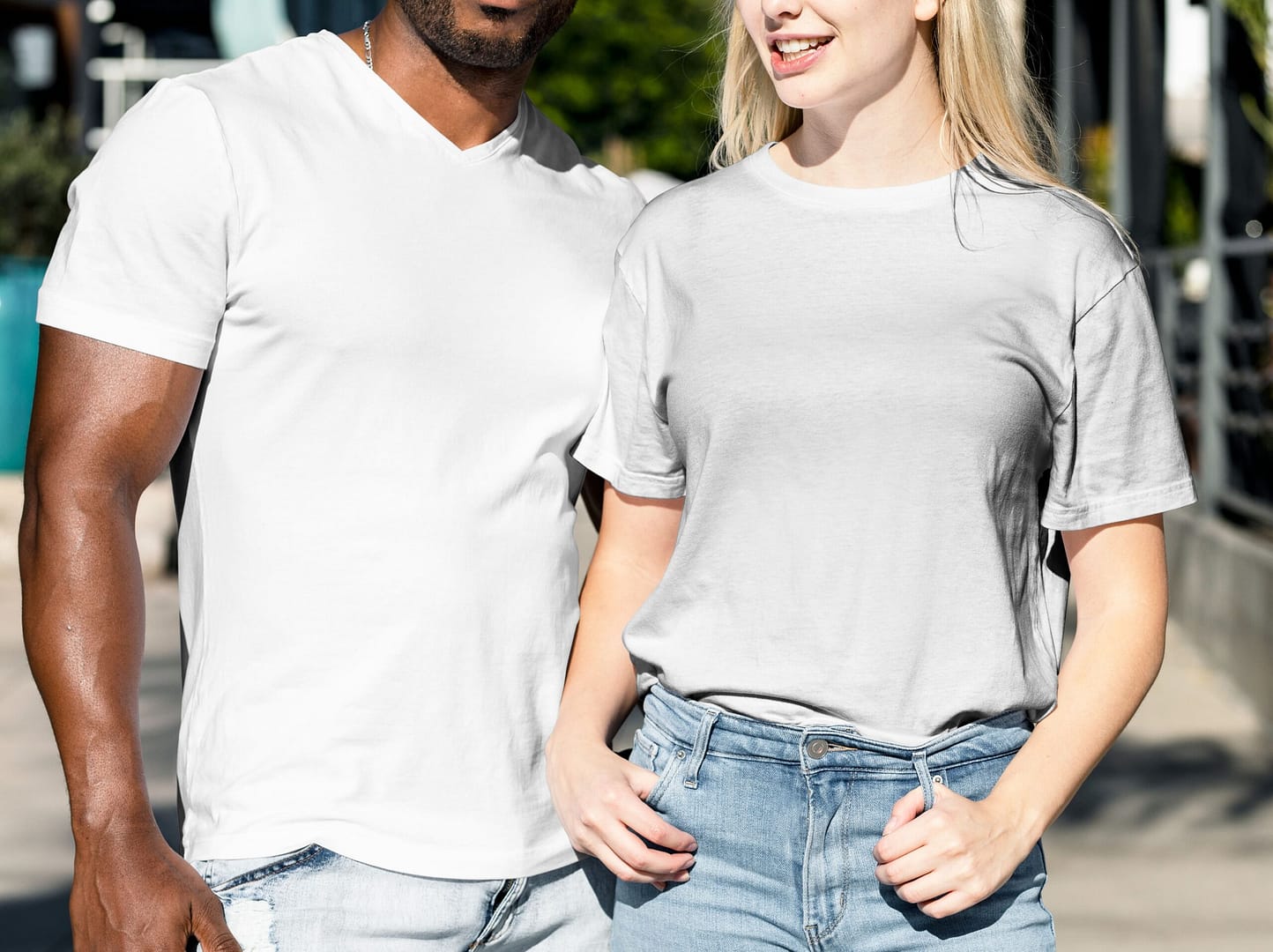The Ultimate Guide to Buttons: Top 14 Types Buttons For Your Apparel
By Raymond Lau – Dec. 16, 2023
Buttons are one of the accessories used in clothing. Initially, they served primarily as fastening devices for garment openings. However, with societal progress and technological advancement, today’s buttons have transcended their original functional role to significantly embody decorative and beautifying elements, enhancing the aesthetic appeal of garments. In a wide array of fashion, one can often see an extensive popularity of variously styled decorative buttons, adding elegance and charm to the garments. As the decorative role of buttons has increased, an array of buttons in diverse shapes and colors has continually emerged. Buttons come in a vast range of designs and varieties. Based on the materials used, they can be categorized into four main types: synthetic material buttons, metal buttons, natural material buttons, and buttons made of other materials.
Synthetic Material Buttons
Synthetic material buttons are currently the most numerous, varied, and popular type in the global button market. They are closely related to everyday life and are a product of the modern chemical industry. Most synthetic materials can be used to make buttons, especially those produced from unsaturated resins, which occupy a large share of the button market. The common characteristics of synthetic material buttons include a rich variety of designs, vibrant colors, suitability for mass production, affordability, and popularity among consumers. However, their disadvantages include less resistance to high temperatures compared to natural material buttons, and as they are made from synthetic polymers, they are more likely to contribute to environmental pollution. The main varieties include resin buttons, ABS injection-molded buttons, electroplated buttons, urea-formaldehyde resin buttons, nylon buttons, and imitation leather buttons.
Resin Buttons
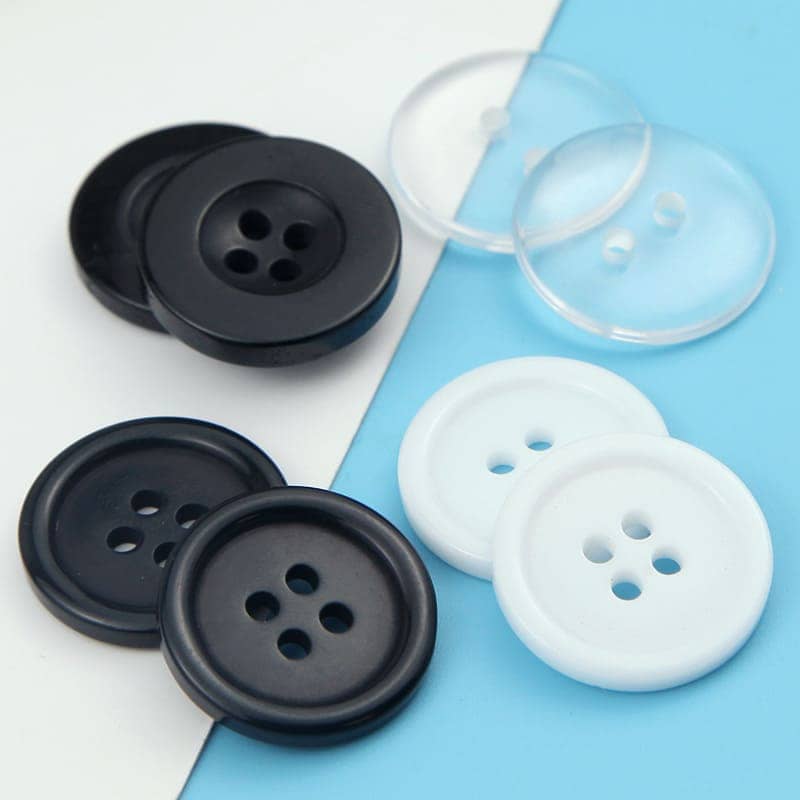
Resin buttons are a type of unsaturated polyester resin button and are considered one of the higher-quality categories within synthetic material buttons. Their main characteristics are:
- Good Abrasion Resistance: Due to the high strength of their material, they can withstand continuous friction in washing machines without breaking, even enduring the rigors of stone washing when used on garments.
- Heat Resistance: They can withstand hot water treatments at around 100°C for about an hour and are suitable for ironing finished garments, but they cannot withstand the high pressure and temperature of pressure cookers.
- Chemical Resistance: Resin buttons can resist corrosion from 30% of various inorganic acids and ordinary hydrogen peroxide, but they should not be soaked for extended periods in ketones, vinegar, banana oil, or alkaline solutions.
- Variety and Vibrant Colors: This is where resin buttons particularly stand out from other types. Their diverse patterns, bright colors, and strong imitation capabilities make them dominant in the global button industry. Any design and color can be produced easily and quickly, with imitation quality that is world-class. Today, realistic imitations of various shell textures, colors, types of wood, animal bones, horns, marble, granite, agate, ivory, and various floral and grass patterns are all possible.
- Excellent Dyeing Properties: A wide variety of dyes suitable for resin buttons are available, with simple dyeing methods, effective dyeing results, bright colors, and good color fastness.
ABS Plastic Buttons
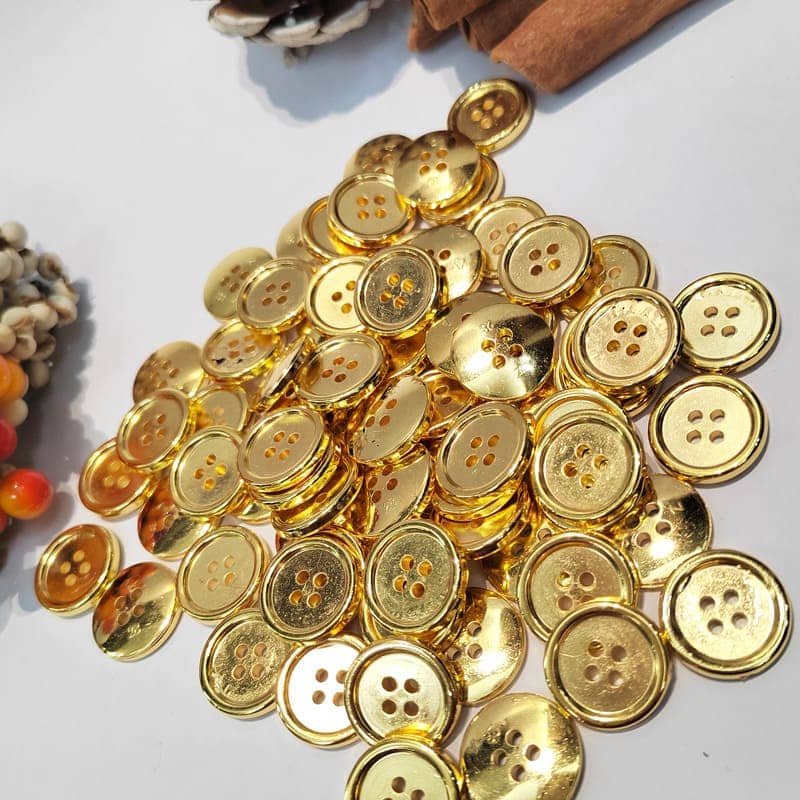
ABS plastic, fully named Acrylonitrile Butadiene Styrene, is a type of thermoplastic known for its excellent injection molding properties and good electroplating capabilities. Electroplated buttons primarily involve coating various ordinary substrates (such as plastic, metal, etc.) with a layer of precious metal or alloy (like gold, silver, or gold imitation) to create a luxurious, aesthetically pleasing, and high-grade decorative button. These buttons are characterized by their vivid colors, rich designs, and strong decorative appeal. Electroplating enhances the hardness, strength, wear, and heat resistance of ordinary plastic or metal bases, and improves their corrosion resistance and detergent resistance properties.
Nylon Buttons
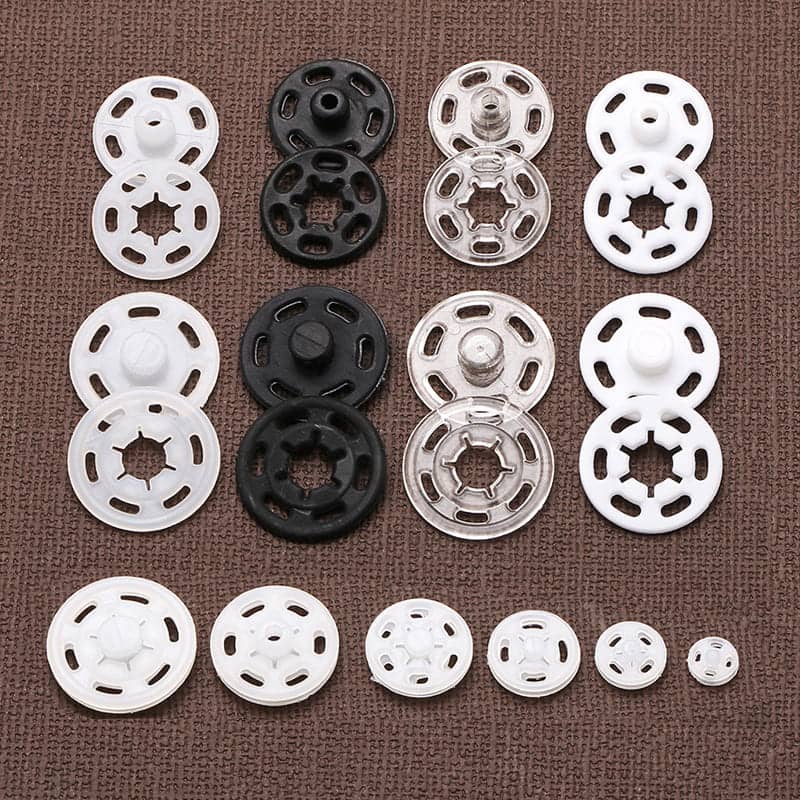
Nylon is a type of thermoplastic engineering plastic, and its buttons are relatively simple to produce using the injection molding method. Its main features are:
- Good Toughness and High Mechanical Strength: This necessitates the design of buttons with stems for durability.
- Excellent Dyeing Properties: Among synthetic resin buttons, nylon buttons have the best dyeing properties. After boiling water bath dyeing, the button’s size remains unchanged, and no post-dyeing treatments like color fixing are needed. Therefore, nylon buttons are often made in their natural color or white, and then dyed into different colors as needed. Due to their good dimensional stability, they are excellent for use in composite button components.
- Strong Mechanical and Chemical Resistance: Nylon can withstand most organic solvents and has excellent abrasion resistance. Nylon buttons can be dry cleaned or washed with garments without damage.
- Effective Pearlescent Arrangement and High Surface Brightness: This makes pearlescent nylon buttons popular in combination with gold-plated ABS parts, creating high-grade pearlescent nylon-ABS gold-plated combination buttons, favored in women’s fashion.
Leather-like Buttons
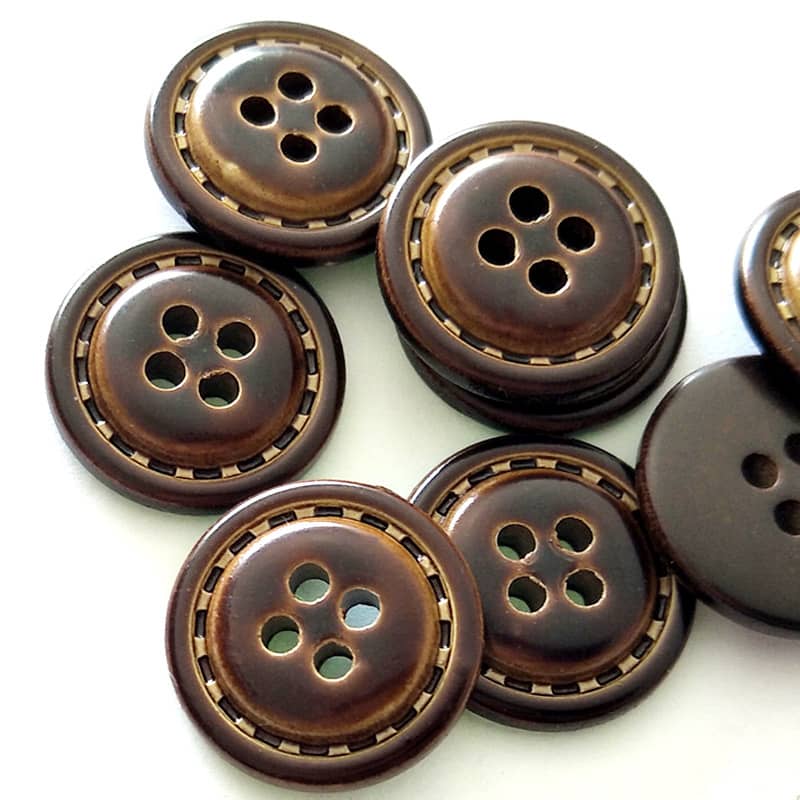
In today’s global apparel market, leather garments occupy a significant proportion. For these types of clothing, apart from using resin buttons and composite buttons, a considerable part employs matching imitation leather buttons. The characteristics of imitation leather buttons are:
- Leather-like Surface Texture: They have a surface texture resembling leather, providing an appearance of leather quality.
- Rich Colors and Variable Surface Gloss: The brightness of the button surface can be easily processed to range from very shiny to matte or even non-glossy effects.
- High Production Efficiency and Low Cost: Although they are efficient to produce and cost-effective, their production cycle is relatively long.
- Material Limitations: Imitation leather buttons are entirely made of synthetic resin, limiting their heat resistance, abrasion resistance, and resistance to organic solvents. Therefore, they should not be ironed with a hot iron, soaked in organic solvents, or subjected to prolonged agitation in washing machines.
Acrylic Buttons
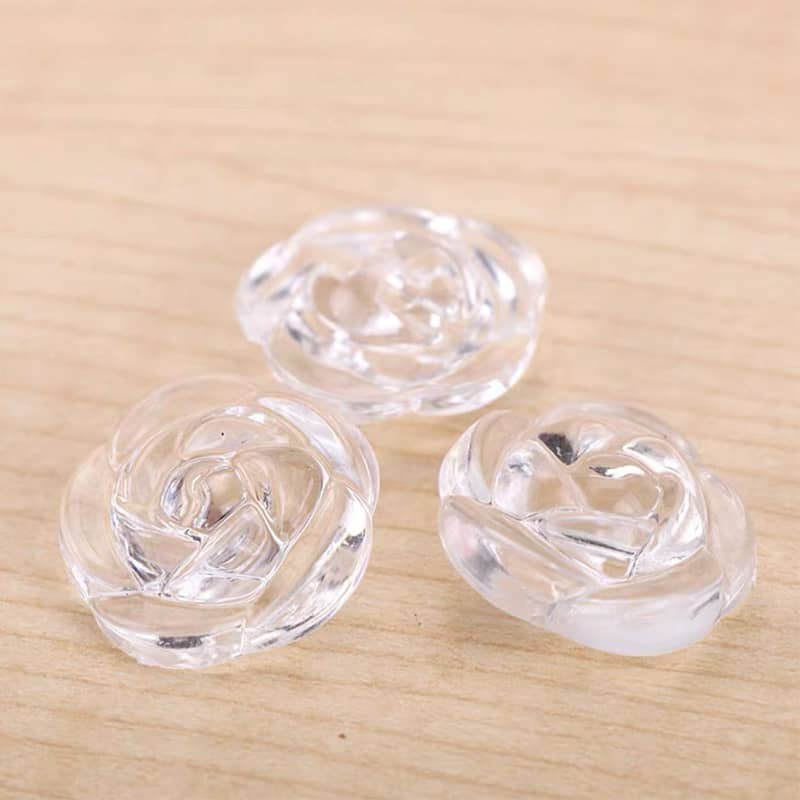
Acrylic used for button-making typically possesses a pearlescent sheen, known as pearlescent acrylic. The characteristics of pearlescent acrylic buttons are:
- Ease of Coloring and Machining: They can be easily colored, and their mechanical processing into various shapes is also straightforward, offering a diverse range of designs.
- Pearlescent Sheen: The entire button exhibits a crystal-clear, sparkling pearl-like luster, making their color extremely vivid under the reflection of pearlescent light.
However, the main disadvantages of these buttons are:
- Poor Abrasion Resistance on the Surface: They are susceptible to scratches and wear.
- Not Resistant to Organic Solvents: Pearlescent acrylic buttons cannot be dry cleaned as they do not withstand organic solvents.
- Low Heat Resistance: They cannot be boiled in water, and prolonged contact with an iron can cause them to melt.
These limitations restrict the development and application of pearlescent acrylic buttons.
Casein Buttons
Casein buttons are made from casein protein derived from milk. Based on their material properties, they should be classified as natural material buttons. However, because their production process is quite similar to that of general plastic buttons, some people categorize them under synthetic material buttons. The characteristics of casein buttons include:
- Texture Similar to Animal Bone: The natural color of casein plastic is close to ivory, earning them the nickname “ivory buttons.” In the button industry, animal imitation ivory buttons usually refer to casein buttons (while plant imitation ivory buttons refer to American nut buttons).
- Highly Detailed Patterns: Casein buttons can be made into a variety of very clear patterns.
- Adjustable Colors and Easy Dyeing: They can be dyed easily in various colors and are safe to use.
- Cost: However, casein buttons are expensive.
Natural Material Buttons
Buttons made from natural materials are among the oldest types, with almost all natural materials being suitable for button manufacturing. Common natural material buttons include shell buttons, wood buttons, bamboo buttons, coconut shell buttons, nut buttons, stone buttons, gemstone buttons, fabric buttons, bone buttons, and horn buttons. Each type of natural material button has its unique characteristics. The main reason people still favor these buttons is not because of their superior physical properties, but because they are derived from nature, closely aligning with people’s daily lives. They cater to the modern desire to return to nature and embrace simplicity, reflecting an aesthetic appreciation for nature in urban life and an increased awareness of environmental conservation.
Of course, natural material buttons also have their own advantages, some of which synthetic buttons cannot match. For example, marine shell buttons, like the mother-of-pearl, have a lustrous, pearl-like appearance, hard texture, and naturally elegant patterns, making them highly prized for high-end clothing and fashion. They represent the finest in button quality, surpassing any synthetic material button. Similarly, certain gemstone buttons and high-quality shell buttons are not only noble and highly decorative but also have high hardness, temperature resistance, and chemical cleaning resistance, qualities unattainable by synthetic material buttons.
Shell Buttons
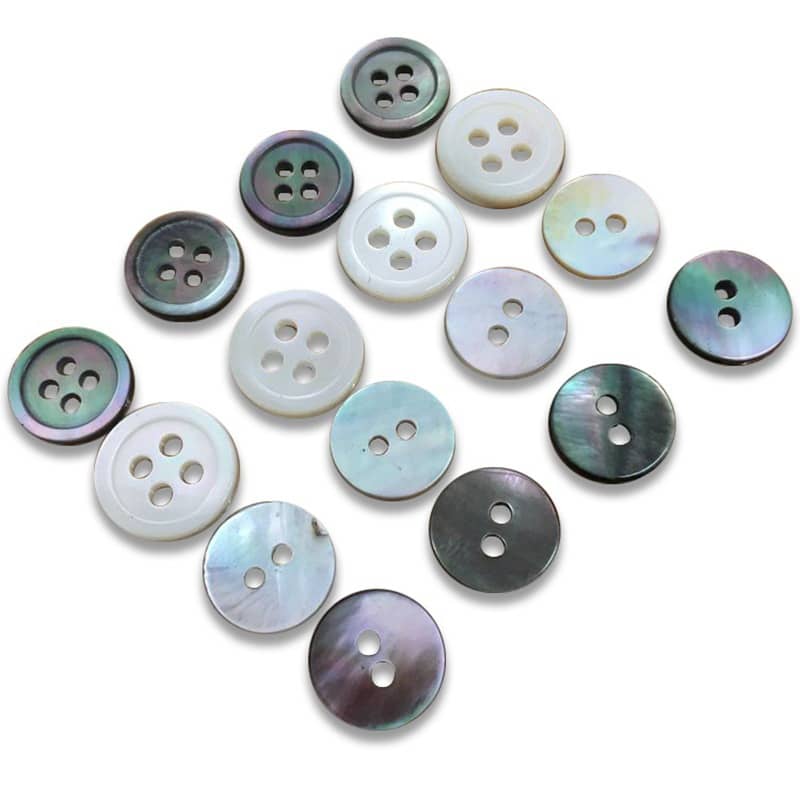
Shell buttons are an extremely ancient type of button, sourced directly from nature. They are known for their elegant texture, enticing luster, and noble quality. Their main characteristics are:
- Soft Pearl Luster: They possess a gentle pearl-like sheen, which is not as dazzling as the luster of pearlescent buttons made from unsaturated resin.
- Hard Texture and Rapid Heat Transfer: This gives them a cool touch sensation.
- Weighty Feel: They have a higher relative density compared to resin buttons.
- Resistance to Organic Solvents: Shell buttons can withstand cleaning with organic solvents without corroding.
- Eco-friendly Natural Product: Buttons made from shells are considered green and environmentally friendly.
However, their main disadvantages are:
- Brittle Material: They can easily break upon impact.
- Sensitive to Hydrogen Peroxide and Acids: Shell buttons corrode in hydrogen peroxide and decompose in acid.
- Lower Color Fastness: Their dye fastness is inferior to resin buttons, reaching only up to level 3.5.
- Inconsistent Thickness: Unlike resin buttons, shell buttons do not have uniform thickness.
- Higher Price Due to Limited Resources: Their cost is relatively high because of the limited availability of natural resources.
Wooden Buttons
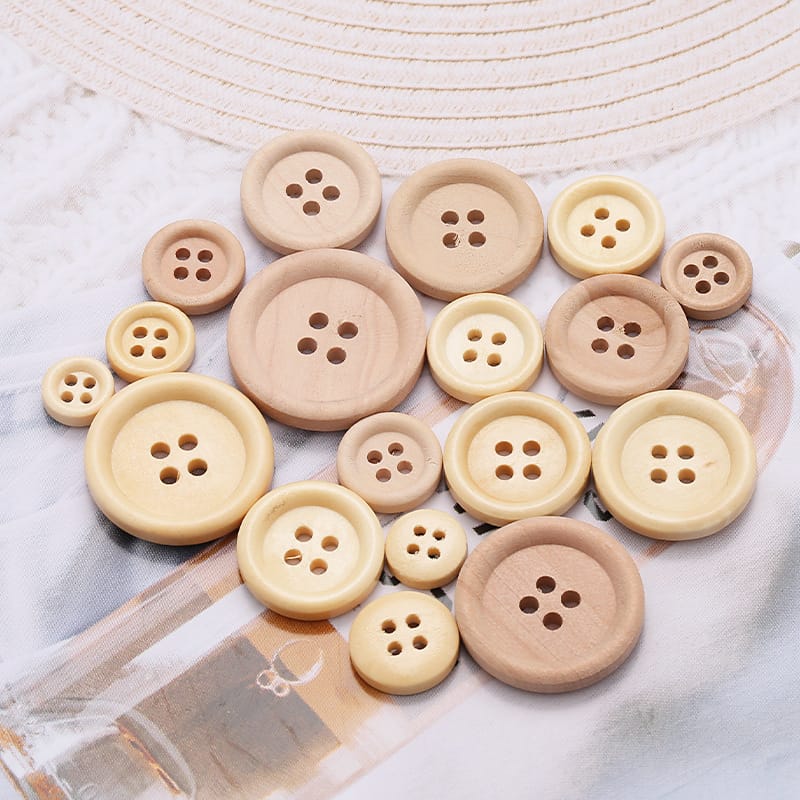
Wooden buttons are made from plant stems and are a significant part of the international button market. Especially in recent years, with the growing environmental consciousness and the trend towards natural and simplistic lifestyles, the demand for these plant-based buttons has been increasing, particularly in industrially developed countries. In terms of product structure, wooden buttons are quite prevalent. Their characteristics include:
- Natural and Non-Toxic: Beneficial for human health and eco-friendly.
- Simple and Rustic: Aligning with the trend towards simplicity and environmental awareness. The natural wood grain texture gives them a rustic and natural look, contrasting sharply with the high gloss of plastic buttons.
- Resistance to Organic Solvents: Being primarily composed of lignin, wooden buttons have strong resistance to organic solvents and can be dry-cleaned with garments.
- Bleachable and Dyeable: They can be bleached to very light colors and then dyed in various vivid hues. However, dyed wooden buttons must undergo a color-fixing process to prevent color bleeding and fabric staining.
Despite these advantages, wooden buttons have a significant drawback: their strong water absorption. In humid weather or when submerged in water, they can quickly absorb moisture and swell, potentially leading to cracking, deformation, or roughness, which can snag fibers in clothing. To overcome this, it’s advisable to select dense woods with longer growth periods and older age. Additionally, after polishing, applying high-quality varnish to the surface can seal all the pores, mitigating the issue of water absorption to some extent.
Coconut Shell Buttons & Nuts Buttons
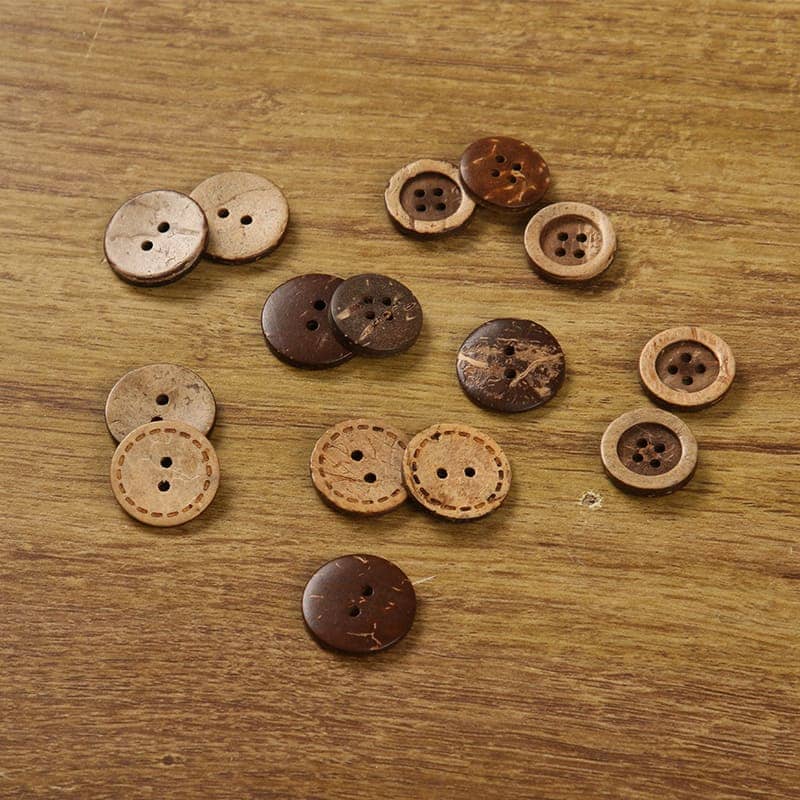
Coconut shell buttons are made from the fruit of the coconut tree, a tropical fruit, while nut buttons are crafted from a type of nut called “corozo,” found in Ecuador and Colombia in Latin America. Coconut shells are very hard, and the buttons made from them feature colors ranging from light to dark brown with different shades on each side. The surface of these buttons is marked with spots or striated veins. They can be bleached and dyed in various colors, but a significant disadvantage is their strong water absorption. Coconut shell buttons are mainly used on casual shirts.
Nut buttons, known for their hard texture, have an elegant and natural pattern similar to urea buttons. Since the nut from South America, when cut open, resembles ivory in color and texture, they are also referred to as plant imitation ivory buttons. These buttons require intricate craftsmanship involving numerous complex processes. Their designs and patterns are clear, dynamic, and vibrant, with soft, natural colors and elegant shapes, making them ideal for high-end garments. Nut buttons are among the higher-grade products in the button market, traditionally symbolizing sophisticated gentlemanly taste and extensively used by renowned clothing manufacturers worldwide. Depending on the part of the nut used, there are generally two types: one made from the outer layer of the nut with brown patterns, and the other made from the inner layer, featuring striated or concentric circular patterns, similar to the fixed patterns of resin buttons.
When using these buttons, care should be taken:
- They have a strong tendency to swell when soaked in water, so prolonged immersion should be avoided.
- They should not come into contact with strong oxidizing agents to prevent cracking.
- The uniformity of color and texture is not always consistent.
- Dyed buttons can fade easily under ultraviolet light exposure and should be stored away from sunlight and in a ventilated, dry place to prevent mold growth in humid conditions.
Stone Buttons
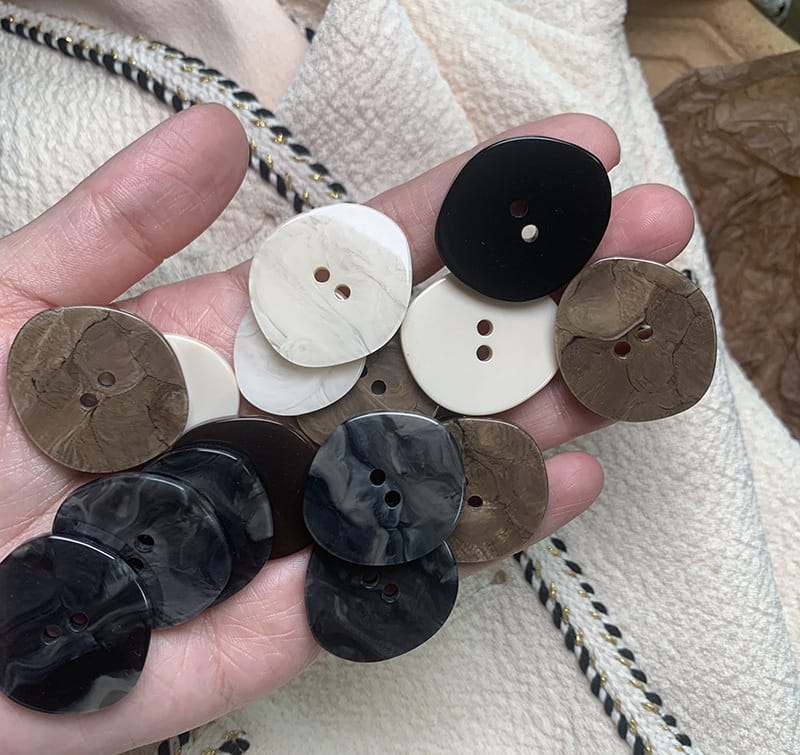
The popular stone buttons on the market are primarily made of marble. Marble buttons, which are now mass-produced using machinery, have distinct characteristics:
- High Hardness and Abrasion Resistance: Marble buttons are known for their extreme hardness and resistance to wear.
- High-Temperature Resistance: They can withstand high temperatures without degrading.
- Resistance to Organic Solvents: Marble buttons are not affected by organic solvents.
- Acid and Alkali Resistance: They are not corroded by acids and alkalis of ordinary concentrations.
- Natural and Unique Patterns: Each button is adorned with various natural patterns, making them unique and elegant.
Ceramic Buttons
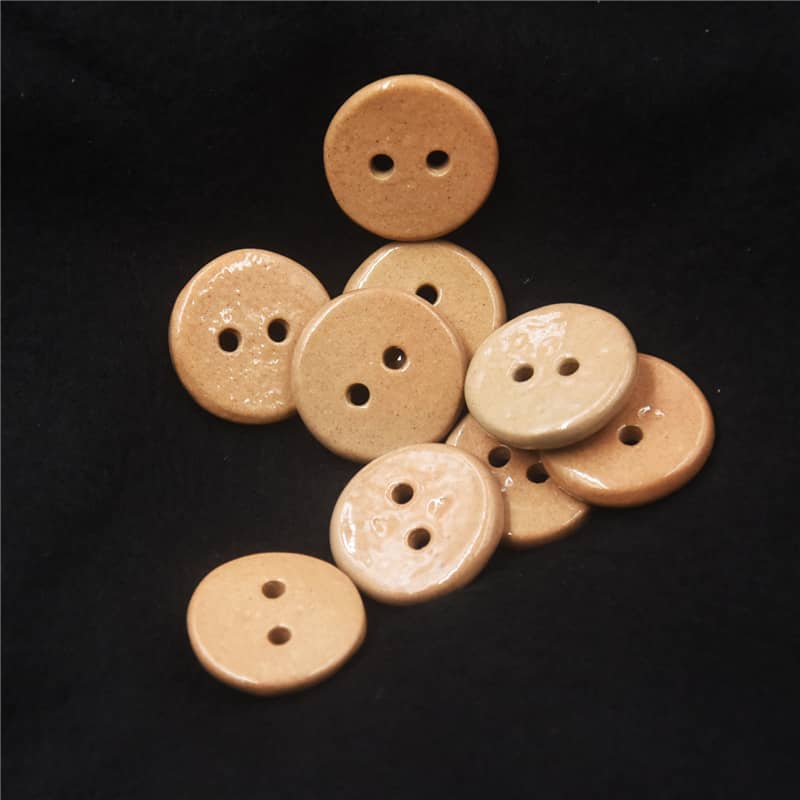
Ceramic buttons can be categorized into two types: ordinary ceramic buttons and special ceramic buttons.
Ordinary ceramic buttons are made from common ceramic materials that are sintered, glazed, and surface-decorated, then combined with a metal base. The glazing process gives these buttons vibrant colors, bright patterns, and a very noticeable decorative effect. Ceramic materials also have a high surface hardness and excellent abrasion resistance. However, due to production methods and technological limitations, they are produced in smaller batches and have higher costs.
Special ceramic buttons, on the other hand, are made from high-strength ceramic materials (like zirconia) through high-pressure molding followed by sintering. These buttons have extremely high mechanical strength and are known as unbreakable buttons. However, they are more expensive and are mainly used as durable, wash-resistant buttons for shirts.
Gem Buttons
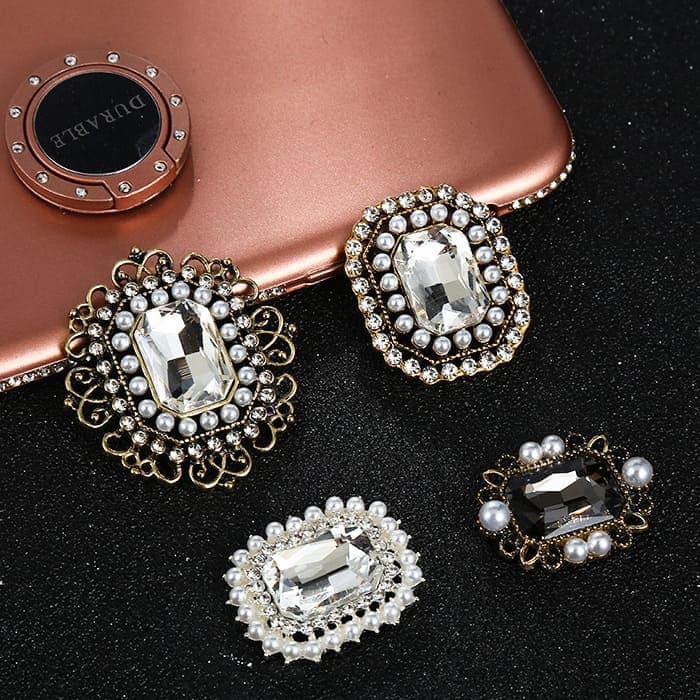
Gemstones, a rare and high-end decorative material, are seldom used in button production. Currently, the gemstones used for button making are primarily lower-grade gems and synthetic crystals. Synthetic crystal buttons, with their clear and luminous colors, are favored by consumers, leading to increasing sales. The main characteristics of gemstone and crystal buttons include:
- Noble Quality: Both gemstones and crystals are rare and valuable materials, lending a sense of luxury to the buttons.
- Excellent Performance: These buttons have superior abrasion resistance and scratch resistance compared to ordinary plastic or even shell buttons. They also withstand organic and inorganic cleaning agents, making them treasured items in the world of buttons. They possess not only functional value but also significant collectible value.
- Exquisite Craftsmanship: Due to the rarity of gemstones, when processed into buttons, they often undergo meticulous carving and shaping, resulting in unique and elegant designs with excellent decorative effects.
Metal Buttons
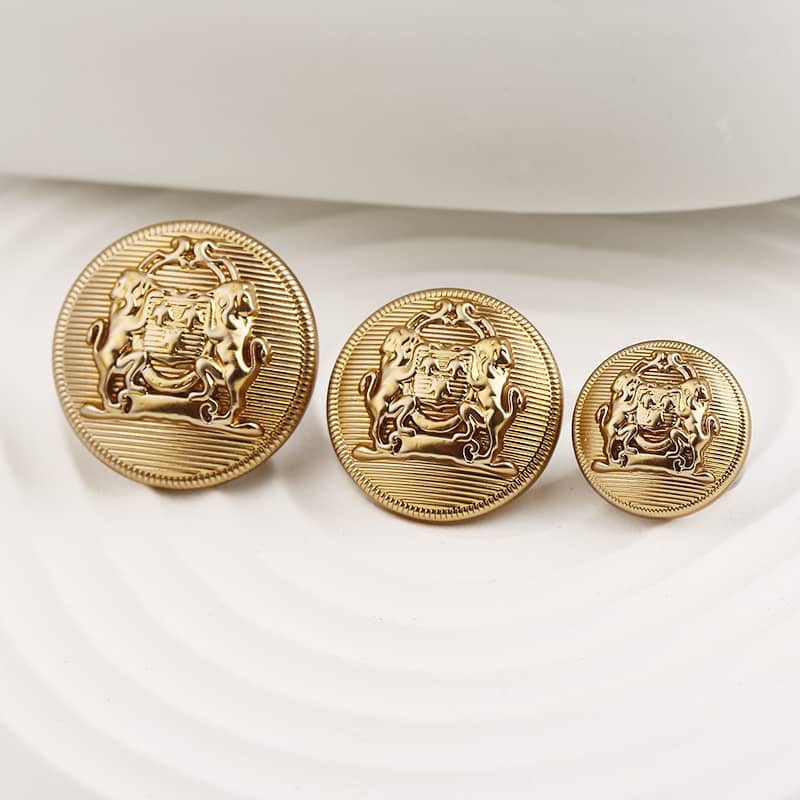
Metal buttons, with their unique blend of durability and elegance, have long been a cornerstone in the realm of fashion accessories. These buttons, crafted from various metals such as brass, nickel, and even precious metals like silver and gold, offer a versatility that is unmatched. Their robustness makes them ideal for a wide range of garments, from casual denim jackets to formal suit blazers. The allure of metal buttons lies not just in their strength, but also in their ability to be molded into countless designs and finishes. Whether it’s a classic, polished look or an intricate, antique finish, metal buttons add a touch of sophistication and timeless appeal to any piece of clothing. Their enduring popularity in the fashion industry is a testament to their functionality and aesthetic value, making them a go-to choice for designers and manufacturers alike.
Conclusion
For those looking to explore the vast possibilities that buttons can bring to apparel, Valtin Apparel is your go-to partner. With our expertise in manufacturing high-quality garments and our flexibility in low MOQ orders, we can help bring your vision to life, whether it involves classic styles or innovative button designs. We invite brand owners, importers, wholesalers, and emerging brands to experience our fast sample production and our commitment to quality and competitive pricing. Connect with us at Valtin Apparel to start your journey in creating apparel that not only looks great but also tells a story through every button. Let’s button up your fashion aspirations together!



